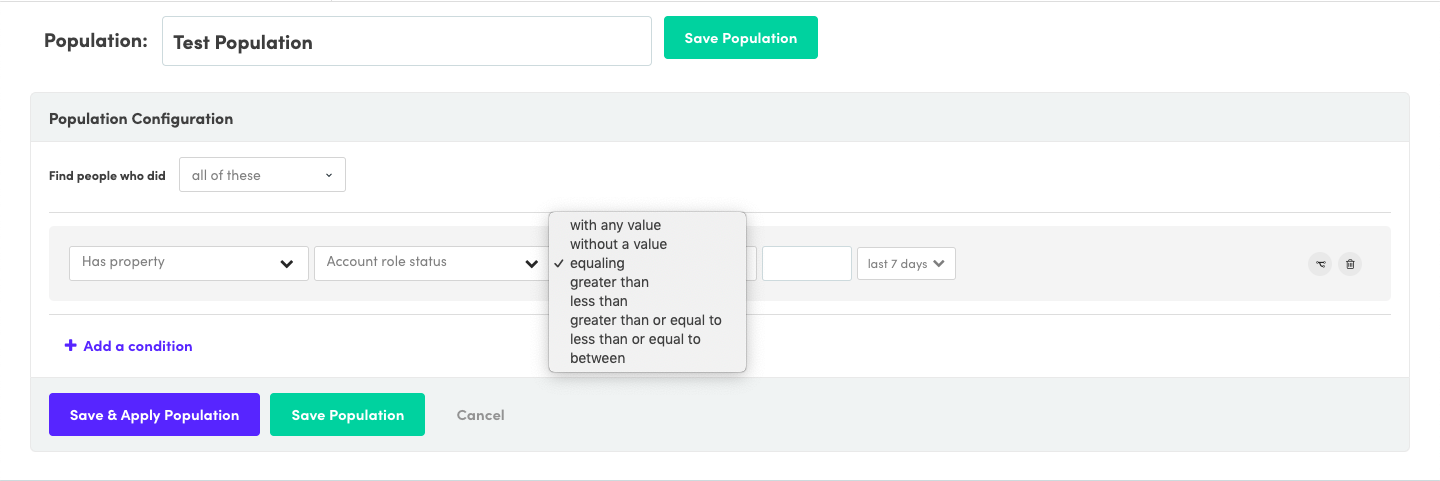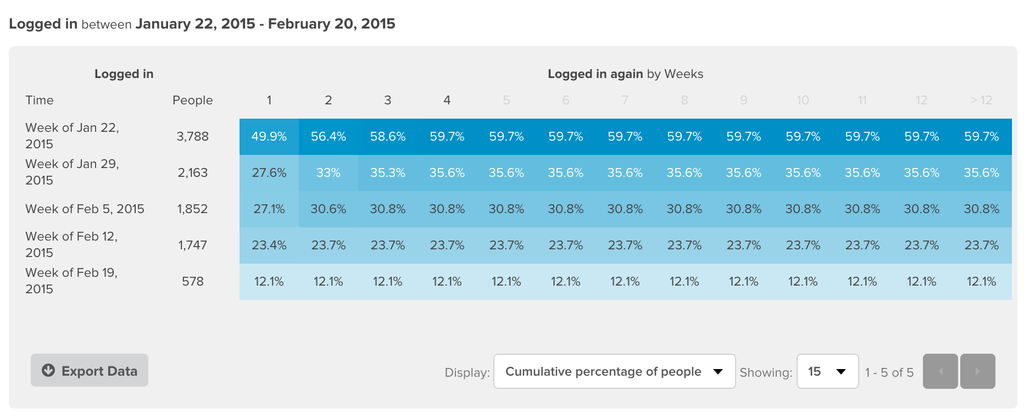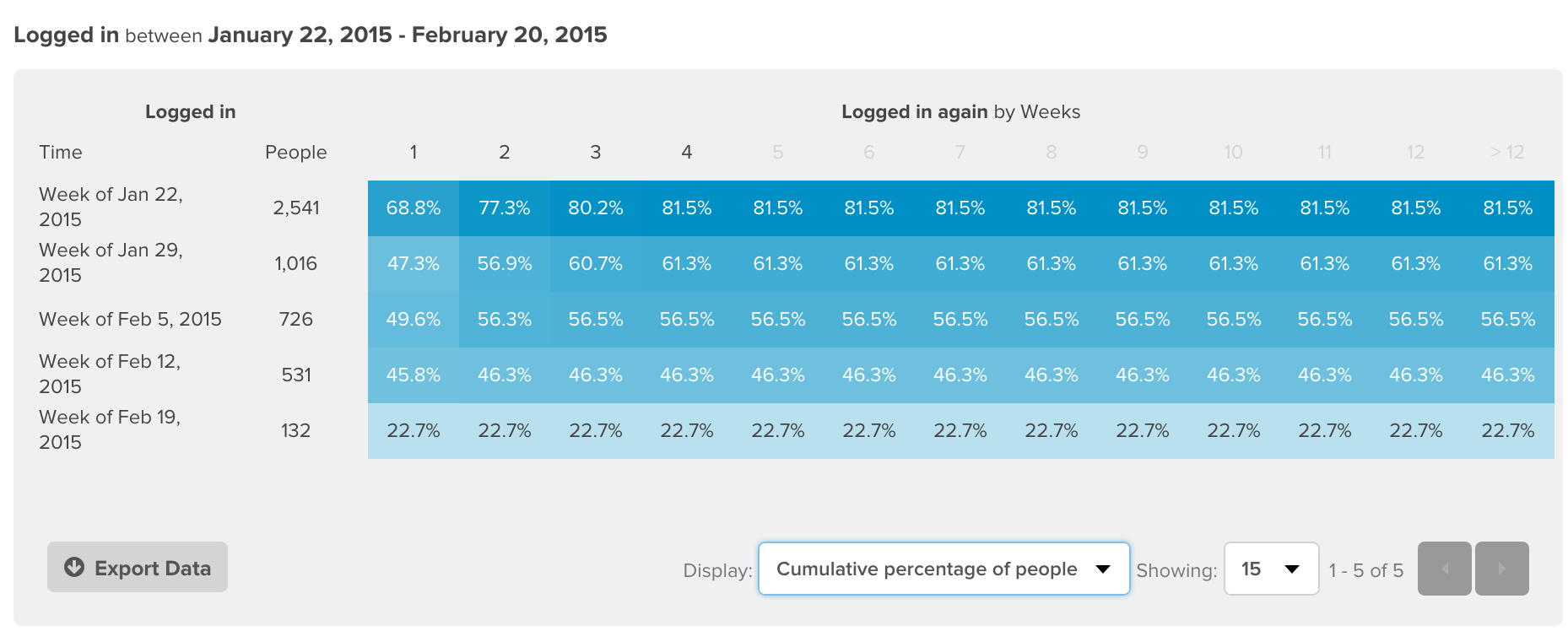Filters
Populations can be used as filters?
Populations are a whole new way to slice and dice the data in your Reports. Look for the people, properties, and events that have the greatest impact on your marketing.
In other words, this feature lets you isolate and analyze subsets of your data. You can use Filters on any report, including the Funnel Report, Cohort Report, Revenue Report, People Search, A/B Test Report, Path Report, and Power Report.
Let’s build some Filters using events and properties that you’ve already been tracking in Kissmetrics.
How to Create a Filter
1. Sign in to your Kissmetrics account
2. Navigate to the Reports section in which you want to create the filter.
3. Under the top navigation, click on Populations
4. Click + Create Population
5. Enter a name for the filter.
7. Choose between Any of these, All of these, and All of these in order.
8. Click on Add Condition
For a user to pass the “Any” filter, they would have to meet any one of the conditions defined in the filter; “All” means that they would have to satisfy all of the conditions, and “All of these in order” means they would have to satisfy the conditions in order, from top to bottom. All three options work exactly as they do in the People Search.
Regardless of which option you choose, your filter conditions will have all of the same parts:
a) Lets you include or exclude events and properties. You can choose between:
- Have done event
- Have NOT done event
- Has property
- Does NOT have property
To include an event or property, select Have done event or Has property respectively.
To exclude an event or property, select Have NOT done event or Does NOT have property respectively.
b) Lets you select the specific event or property that you want to filter.
- For events, you can choose from: at least (≥), at most (≤) and exactly (=).
- For properties, you can choose from: containing, with any value, equaling, beginning with, ending with
c) Represents text or numerical value we want to match against.
d) Lets you select the time period for which the particular condition is true.
Once you’ve set all of the desired conditions, click Save and Apply.
How to Apply Filter
Once you’ve saved a Filter, your saved Filters will show up in the Filter dropdown menu. You can select a population from the menu to quickly apply it with one click. You can tell that a Filter is Active by seeing whether the Filter icon is green or not. We’ve also labeled an Active filter with the words “Filter Active” just in case you miss it.
When you navigate from one report to another report, Filters will stick and stay active until you click Clear filter. Here’s what the filter menu looks like.
How to Manage Filters
Once you create a filter, you can edit its name, delete it or clone it.
- Click on the Filters dropdown menu
- Hover over the filter that you want to edit, delete or clone
- Click on the corresponding icon:
- To edit: click on the pencil icon
- To clone: click on the stacked-papers icon
- To delete: click on the trash can icon

Examples of Populations To Get You Started
In this tutorial, you’ll learn how to use Filters in four ways: (1) hide traffic from your own activity, (2) hide traffic from internal staff, (3) dig in to see if your users are engaging with your app over time and (4) manage your populations by editing, cloning and deleting them.
Hide Your Activity from Reports
When a visitor goes to your site, their activity is logged by Kissmetrics. To avoid recording your own activity, create the following filter:

- Go to any Report
- Click on the Filters dropdown at the top right. Then, click on + Create New Population
- Give your filter a name
- Click on Edit Name and type in a name for the filter. In this example, we’re naming the filter as Exclude Myself. Save the new filter name.
- Select: Does NOT Have Property, Customer ID, containing
- Type in your email address. In this example, I’m going to exclude myself and type in “[email protected]”
- Click Save & Apply Filter
Hide Other Internal Traffic

To exclude all internal traffic, you can use a version of this filter. This may be helpful if you have employees who visit your site frequently, but you don’t want to include them in your data.
1.Click on the Populations dropdown
2. Click on + Create New Populations
3. Give your Populations a name
4. Click on Edit Name and type in a name for the Populations. In this example, we’re naming the Populations as Exclude Internal Staff. Save the new Populations name.
5. Select: Does NOT Have Property, Customer ID, containing
6. Type in your company’s email address. In this example, I’m going to exclude Kissmetrics staff from the data and type in “@kissmetrics.io.” This will change based on what your company’s email is. For example, if you work for Apple, you could type in “@apple.com”
7. Click Save & Apply Populations
Refine Your Understanding of Power Users
You can refine your understanding of your site’s Power Users by leveraging the Cohort Report and the Populations feature. Together, these two tools let you see if your users are engaging with your app over time. For example, we could ask: “After Power Users log-in to the app, do they continue to log-in week after week?"
The Underlying Cohort Report

-
Create a new Cohort Report
-
Click on Edit Name and name the Populations, “What effect do emails have on Retention?”
-
Click on Logged in and Logged in so that it says “Show me the time between people who did Logged in and Logged in”
-
For the date range, select Last 30 days
-
Select “Show each cohort as Weekly buckets”
-
Select Show how long it takes for people to come back as Weekly buckets
-
Click on Run Report
-
At the bottom right, change the dropdown to Cumulative percentage of people.
Cumulative percentage lets you see the total amount of people that have logged into your site app for each cohort. You should see a colorful, blue chart like this:

Let’s breakdown what’s going on in this Cohort Report. Each row of the chart represents a cohort of people based on what week they first logged in. The columns represent the number of weeks that elapsed between the start event and the return event.

All of these data points are based on the entire user base. Looking at the top row of the chart, we see that 3,788 users first logged in between January 22 to January 28th. Of those users, 49.9% came back and logged in the same week. 56.4% came back and logged in 1-2 weeks later.
Uncover Power User Habits with the Cohort Report
Great! For the third part, let’s run the Cohort Report to gather data based on the cohort of people who are Power Users.
- Click on Run Report.
The numbers will change. These data points are NOT based on the entire user base. Because we ran the Power Users Populations as a filter, these data points represent a cohort of people who are power users.
Let’s breakdown what’s going on in this Cohort Report. Each row of the chart represents a cohort of people based on what week they first logged in. The columns represent the number of weeks that elapsed between the start event and the return event.
Looking at the top row of the chart, we see that 2541 Power Users first logged in between January 22 to January 28th. Of those Power Users, 68.8% came back and logged in the following week. 77.3% Power Users came back and logged in 2 weeks later.

- Compare the numbers side-by-side. Here are two screenshots of what’s going on.

Cohort comparison
On the left side, you have retention numbers for all users. For the right screenshot, you have retention data based on only power users.
Earlier, we asked, After Power Users log-in to the app, do they continue to log-in week after week?
With the Population and the Cohort Report, the data suggests that within the first two weeks of usage, Power Users log in to our site 1.4x more than the entire user base. With this sort of intel, you can use this data to inform your marketing decisions and product research.
Voila, you’ve just used Populations to sift and analyze your data!
Updated 7 months ago
